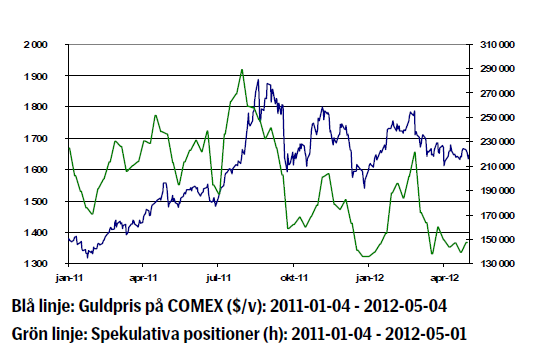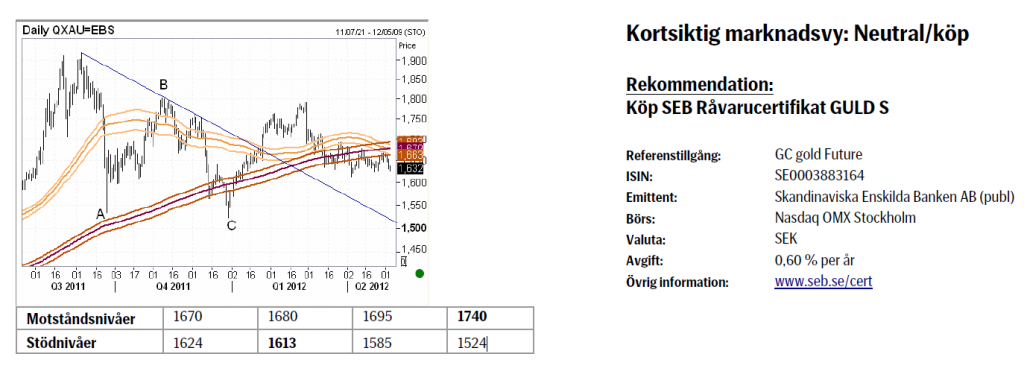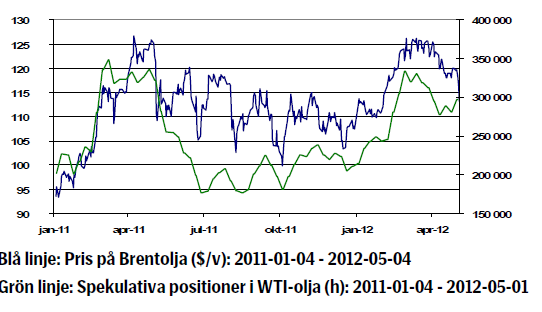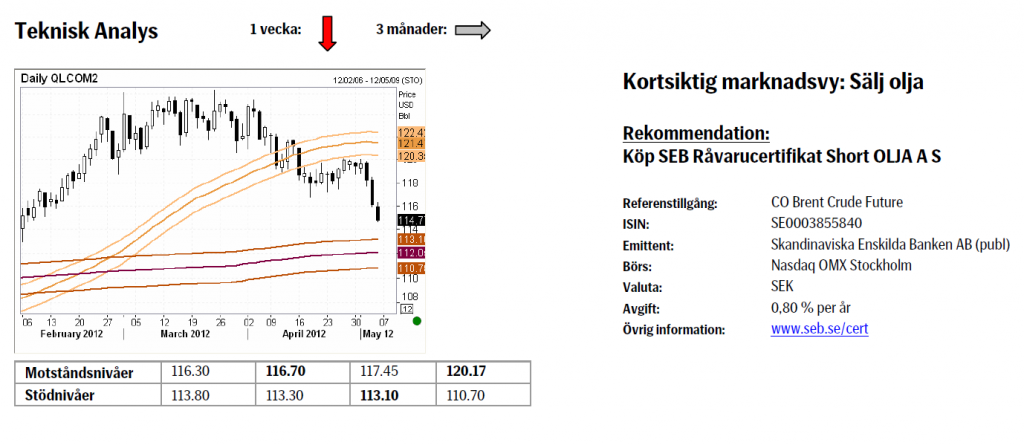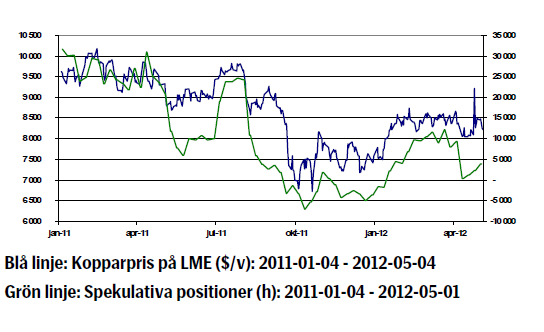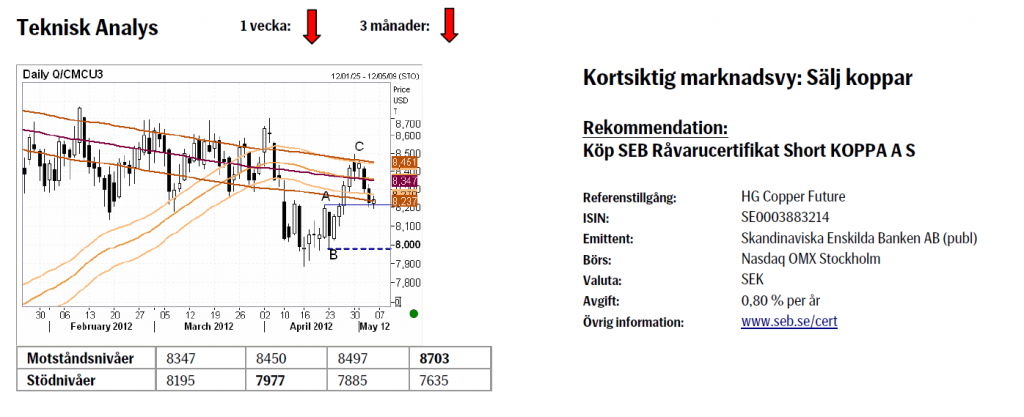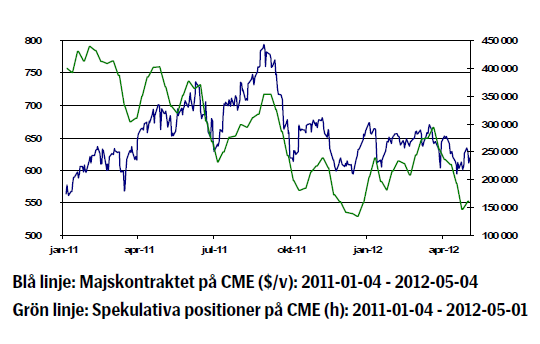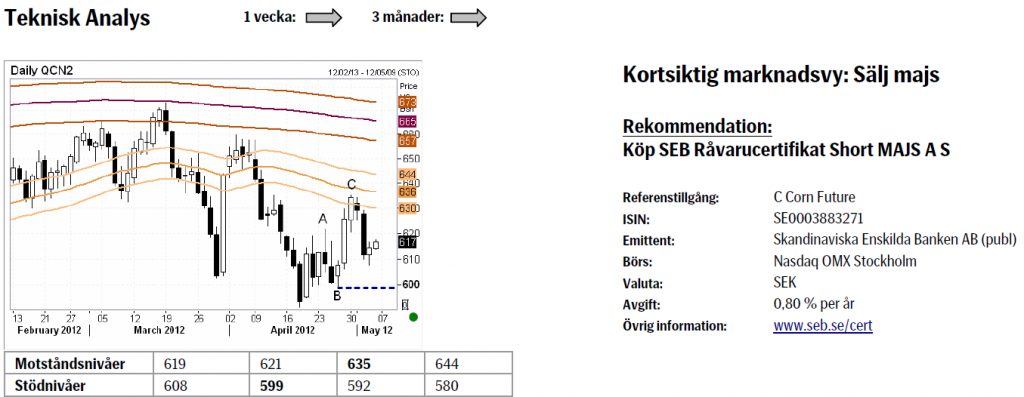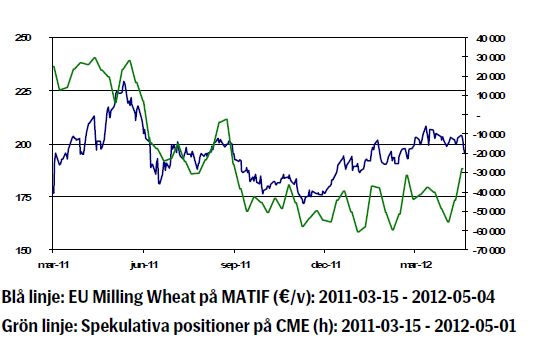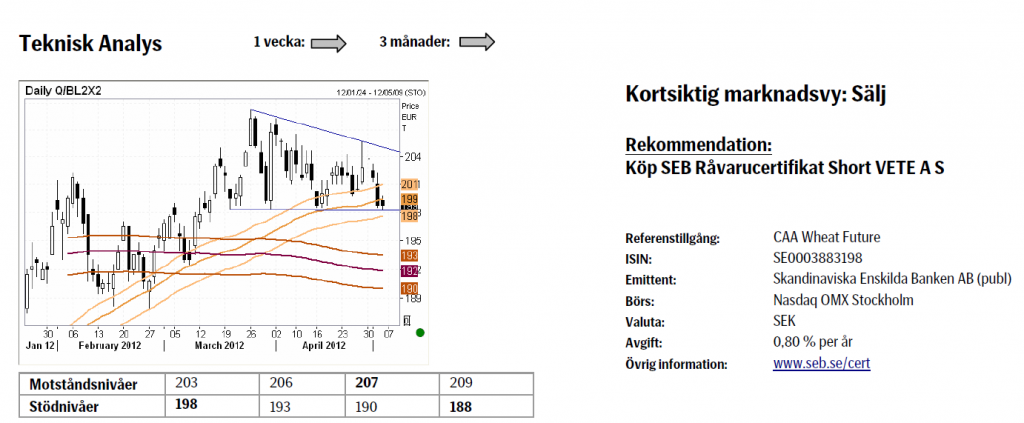Analys
SEB – Råvarukommentarer vecka 19 2012
Sammanfattning: Föregående vecka
 Brett råvaruindex: -2,79 %
Brett råvaruindex: -2,79 %
UBS Bloomberg CMCI TR Index- Energi: -4,31 %
UBS Bloomberg CMCI Energy TR Index - Ädelmetaller: -1,59%
UBS Bloomberg CMCI Precious Metals TR Index - Industrimetaller: -2,42 %
UBS Bloomberg CMCI Industrial Metals TR Index - Jordbruk: -2,01 %
UBS Bloomberg CMCI Agriculture TR Index
Kortsiktig marknadsvy:
- Guld: Neutral/köp
- Olja: Sälj
- Koppar: Sälj
- Majs: Sälj
- Vete: Sälj
Guld
- Guldet föll 1,14 procent förra veckan och vi såg att guldtillgångar i börshandlade ETP: er sjönk till 2 381 ton, den lägsta nivån sedan 1 februari i år. Guldet handlade i ett intervall och lyckas inte bryta på uppsidan. Bristen på av politiker bekräftade penningpolitiska lättnader och en starkare dollar höll tillbaka guldet.
- Den amerikanska jobbrapporten NFP som publiceras i fredags kom ut sämre än förväntat, 115 000 nya jobb mot förväntade 160 000 nya jobb skapades. NFP siffran ökade marknadens förhoppningar om nya kvantitativa lättnader vilket gav stöd åt guldet som steg en halv procent samtidigt dollarn försvagades marginellt.
- Råvaror faller brett idag på morgonen efter valseger för Hollande i Frankrike. Segern skapar politisk oro eftersom överenskommelser med Tyskland nu kan komma att rivas upp. Helgens val i Grekland gav en klar seger för små partier som visat missnöje med de överenskommelser landets största partier gjort med EU och IMF. Osäkerheten i Europa ökar och euron tappade kraftigt mot dollarn efter valresultaten.
- I Europa är osäkerheten kring Spanien stor där ekonomin åter är i recession, dvs. ekonomin krymper för andra kvartalet i rad. En fråga som oroar marknaden är om Spanien kommet att behöva resurser från EU:s nödlånefaciliteter. Negativa nyheter kan snabbt skapa turbulens i marknaden. Den oro man ser i Europa har emellertid inte ökat intresset för guld som säker hamn. Guldet har snarare korrelerat positivt med övriga risktillgångar.
- Teknisk Analys: Fortsatt endast marginella rörelser noterade inom ett redan ganska väl utstakat intervall där under $1620 verkar ”för lågt” och over $1690 ”för högt”. Priset håller sig under ett rullande 55-dagars genomsinittsband. Bandet är svagt i fallande och är på marginalen ett uttryck för visst nedåttryck, men marknaden svarar samtidigt bra på nedställ och i en större positiv bild ser eventuell svaghet ut at vara temporär. Över $1670 & $1695 skulle påvisa efterfrågan och ses som positivt.
Olja
- Oljepriset föll 5,3 procent förra veckan. Statistik från USA:s energidepartement, DOE, visade att de amerikanska lagren av råolja steg med 2,8 miljoner fat under förra veckan till den högsta nivån på 21 år.
- Den viktiga amerikanska jobbrapporten NFP som publiceras på fredagen kom ut sämre än förväntat, 115 000 nya jobb mot förväntade 160 000 nya jobb skapades.
- Arbetslösheten minskade med 0,1 % och föll till 8,1 procent (samtidigt bör noteras att antalet registrerade arbetslösa minskade, de försvinner alltså ur systemet vilket i sig förbättrar siffran).
- Den inofficiell amerikanska jobbstatistiken, ADP-rapporten, som mäter utvecklingen i den privata sysselsättningen, visade på en ökning om 119 000 personer vilket också var långt under väntade 170 000.)
- Opec:s generalsekreterare är “inte nöjd” över nuvarande oljepris och kartellen arbetar för att få ned priserna. Enligt Opec som idag producerar 3,2 miljoner fat per dag över de uppsatta kvoterna, är ett oljepris kring 100 dollar att föredra. Enligt Opec finns det gott om olja och utbudssituationen är inte ett problem trots Irankrisen. Exporten från Iran har minskat mindre än förväntat. Detta, tillsammans med Europas kris, gör att vi kortsiktigt inte tror på en uppgång i oljepriset.
- Teknisk Analys: Undersidan av 55-dagars bandet (som efter kraftigt nedställ denna vecka är satt i fallande) agerar som dynamisk motstånd (borde inte återtestas under de kommande veckorna). Rörelsen ner är som sagt hård och ska väntas fortsätta för att testa 233-dagars bandet som just nu börjar vid $113.
Koppar
- Kopparlagren på LME (London Metal Exchange) föll förra veckan till den lägsta nivån sedan november 2008.
- HSBC inköpschefsindex för tillverkningsindustrin kom in under 50-nivån vilket är den nivå som indikerar att ekonomin är i kontraktion. Fastighetspriser i Kina faller och föll i april till 14-månaders lägsta. Husbyggande står för ungefär 40 procent av inhemsk efterfrågan på koppar enligt Copper Development Association.
- ECB lämnade som förväntat räntan oförändrad på en procent. Störst fokus var emellertid på ECB chefen Draghis efterföljande presskonferens i samband med räntebeskedet där Draghi uttryckte kritik mot euro-ländernas politiker vilka inte har förbättrat tillväxtpotentialen med förbättrade strukturreformer. Framtiden ser osäker ut enligt Draghi som inte heller utlovade ytterligare stimulanser vilket marknaden reagerade negativt på och råvaror fortsatte att falla brett på fredagen i samklang med aktiemarknaden.
- Stämningsläget hos europeiska inköpschefer bekräftade det kärva läge som europeisk tillväxt befinner sig i. Arbetsmarknadsstatistiken är dyster och den europeiska arbetslösheten har stigit till 15-årshögsta. Obligationsräntorna har rört sig nedåt eller ligger kvar på mycket låga nivåer t.o.m. i ekonomier som bedöms som säkra att låna ut till.
- Teknisk Analys: Rörelsen högre gick något längre än vad som tidigare var trott, men uppsidan av 55-, & 233-dagars ”banden” höll köpare över $8500 nivån borta. Den nuvarande överlappningen under 20 april toppen vid $8218 har ökat sannolikheten att apr/maj rörelsen verkligen är den korrektion vi antagit att den är. Under $$7977 skulle helt bekräfta detta och starkt argumentera för fortsatt rörelse under apr botten vid 7885.
Majs
- Denna vecka byter vi referenskontrakt för majs. Från att den senaste tiden ha använt majkontraktet byter vi nu istället till julikontraktet.
- Förra veckan kunde vi se en nedgång med knappt en procent, detta till följd av framförallt den fortsatt goda utvecklingen för den amerikanska majsskörden, där mer än 50 procent av planteringen nu är avslutad.
- Prognoserna för den sydamerikanska majsskörden ser fortsatt blandade ut, där Brasilien som kontinentens största producent justerat upp sin prognos samtidigt som Argentina fått dra ned sina estimat något.
- Den senaste tiden har det spekulerats mycket kring Kinas ökade import av majs och huruvida denna kommer att fortlöpa under 2012. Enligt en mängd analytiker verkar det i nuläget som att importen kommer att öka något, vilket borde utgöra ett starkt fundamentalt motstånd för majspriset.
- Fundamentalt förhåller vi oss fortsatt negativa till majspriset, där fredagens amerikanska arbetsmarknadsdata, tillsammans med den generella riskaversionen i kapitalmarknaden, bör agera sänke även på spannmålspriserna denna vecka.
- Teknisk Analys: Rörelsen upp från apr botten har kommit av sig och börjat se ut som en korrektiv ”3-vågs” rörelse där A-, & C-vågorna nu är symmetriska i storlek och hastighet. Tillbaka under 599 skulle till fullo bekräfta detta och den lätt negativa lutningen på 55-dagars bandet och då argumentera för rörelse under 592, möjligtvis ner mot 580-området.
Vete
- Efter att den senaste månaden ha använt majkontraktet som referenskontrakt för europeiskt vete byter vi nu över till novemberkontraktet.
- Förra veckan föll priset på vete med nästan 3,5 procent, vilket till stor del kan förklaras av den amerikanska skördeutvecklingen, där 64 procent av vintervetet är av hög eller mycket hög kvalitet. Den gängse normen på marknaden är att en siffra över 60 procent i regel leder till hög avkastning på skörden.
- I Europa är det fortsatt blandat, där exempelvis skörden i Ukraina och Spanien i år ser ut att bli väsentligen sämre jämfört med föregående skördeår. I länder som Ryssland och Frankrike ser det däremot förhållandevis ljust ut, där det blöta vädret under april och maj skapat förutsättningar för en god avkastning.
- Som en konsekvens av rådande riskaversion samt de goda utsikterna för den amerikanska skörden är vi denna vecka säljare av vete. Det krävs en svag WASDE-rapport på torsdag för att vi ska revidera denna kortsiktiga vy.
- Teknisk Analys: Fallande toppar indikerar ett något höjt säljtryck. Skulle stödet just under €200-nivån (& nedsidan på 55-dagars bandet) sluta att attrahera köpare så väntas snabb rörelse tillbaka ner mot stödet vid 233-dagars bandet (som är i fallande) och som börjar vid €193. Över €206 skulle åter minska risken för brott lägre och i stället tas som efterfrågan vid nivåer som tidigare.
[box]SEB Veckobrev Veckans råvarukommentar är producerat av SEB Merchant Banking och publiceras i samarbete och med tillstånd på Råvarumarknaden.se[/box]
Disclaimer
The information in this document has been compiled by SEB Merchant Banking, a division within Skandinaviska Enskilda Banken AB (publ) (“SEB”).
Opinions contained in this report represent the bank’s present opinion only and are subject to change without notice. All information contained in this report has been compiled in good faith from sources believed to be reliable. However, no representation or warranty, expressed or implied, is made with respect to the completeness or accuracy of its contents and the information is not to be relied upon as authoritative. Anyone considering taking actions based upon the content of this document is urged to base his or her investment decisions upon such investigations as he or she deems necessary. This document is being provided as information only, and no specific actions are being solicited as a result of it; to the extent permitted by law, no liability whatsoever is accepted for any direct or consequential loss arising from use of this document or its contents.
About SEB
SEB is a public company incorporated in Stockholm, Sweden, with limited liability. It is a participant at major Nordic and other European Regulated Markets and Multilateral Trading Facilities (as well as some non-European equivalent markets) for trading in financial instruments, such as markets operated by NASDAQ OMX, NYSE Euronext, London Stock Exchange, Deutsche Börse, Swiss Exchanges, Turquoise and Chi-X. SEB is authorized and regulated by Finansinspektionen in Sweden; it is authorized and subject to limited regulation by the Financial Services Authority for the conduct of designated investment business in the UK, and is subject to the provisions of relevant regulators in all other jurisdictions where SEB conducts operations. SEB Merchant Banking. All rights reserved.
Analys
Tightening fundamentals – bullish inventories from DOE

The latest weekly report from the US DOE showed a substantial drawdown across key petroleum categories, adding more upside potential to the fundamental picture.

Commercial crude inventories (excl. SPR) fell by 5.8 million barrels, bringing total inventories down to 415.1 million barrels. Now sitting 11% below the five-year seasonal norm and placed in the lowest 2015-2022 range (see picture below).
Product inventories also tightened further last week. Gasoline inventories declined by 2.1 million barrels, with reductions seen in both finished gasoline and blending components. Current gasoline levels are about 3% below the five-year average for this time of year.
Among products, the most notable move came in diesel, where inventories dropped by almost 4.1 million barrels, deepening the deficit to around 20% below seasonal norms – continuing to underscore the persistent supply tightness in diesel markets.
The only area of inventory growth was in propane/propylene, which posted a significant 5.1-million-barrel build and now stands 9% above the five-year average.
Total commercial petroleum inventories (crude plus refined products) declined by 4.2 million barrels on the week, reinforcing the overall tightening of US crude and products.


Analys
Bombs to ”ceasefire” in hours – Brent below $70

A classic case of “buy the rumor, sell the news” played out in oil markets, as Brent crude has dropped sharply – down nearly USD 10 per barrel since yesterday evening – following Iran’s retaliatory strike on a U.S. air base in Qatar. The immediate reaction was: “That was it?” The strike followed a carefully calibrated, non-escalatory playbook, avoiding direct threats to energy infrastructure or disruption of shipping through the Strait of Hormuz – thus calming worst-case fears.

After Monday morning’s sharp spike to USD 81.4 per barrel, triggered by the U.S. bombing of Iranian nuclear facilities, oil prices drifted sideways in anticipation of a potential Iranian response. That response came with advance warning and caused limited physical damage. Early this morning, both the U.S. President and Iranian state media announced a ceasefire, effectively placing a lid on the immediate conflict risk – at least for now.
As a result, Brent crude has now fallen by a total of USD 12 from Monday’s peak, currently trading around USD 69 per barrel.
Looking beyond geopolitics, the market will now shift its focus to the upcoming OPEC+ meeting in early July. Saudi Arabia’s decision to increase output earlier this year – despite falling prices – has drawn renewed attention considering recent developments. Some suggest this was a response to U.S. pressure to offset potential Iranian supply losses.
However, consensus is that the move was driven more by internal OPEC+ dynamics. After years of curbing production to support prices, Riyadh had grown frustrated with quota-busting by several members (notably Kazakhstan). With Saudi Arabia cutting up to 2 million barrels per day – roughly 2% of global supply – returns were diminishing, and the risk of losing market share was rising. The production increase is widely seen as an effort to reassert leadership and restore discipline within the group.
That said, the FT recently stated that, the Saudis remain wary of past missteps. In 2018, Riyadh ramped up output at Trump’s request ahead of Iran sanctions, only to see prices collapse when the U.S. granted broad waivers – triggering oversupply. Officials have reportedly made it clear they don’t intend to repeat that mistake.
The recent visit by President Trump to Saudi Arabia, which included agreements on AI, defense, and nuclear cooperation, suggests a broader strategic alignment. This has fueled speculation about a quiet “pump-for-politics” deal behind recent production moves.
Looking ahead, oil prices have now retraced the entire rally sparked by the June 13 Israel–Iran escalation. This retreat provides more political and policy space for both the U.S. and Saudi Arabia. Specifically, it makes it easier for Riyadh to scale back its three recent production hikes of 411,000 barrels each, potentially returning to more moderate increases of 137,000 barrels for August and September.
In short: with no major loss of Iranian supply to the market, OPEC+ – led by Saudi Arabia – no longer needs to compensate for a disruption that hasn’t materialized, especially not to please the U.S. at the cost of its own market strategy. As the Saudis themselves have signaled, they are unlikely to repeat previous mistakes.
Conclusion: With Brent now in the high USD 60s, buying oil looks fundamentally justified. The geopolitical premium has deflated, but tensions between Israel and Iran remain unresolved – and the risk of missteps and renewed escalation still lingers. In fact, even this morning, reports have emerged of renewed missile fire despite the declared “truce.” The path forward may be calmer – but it is far from stable.
Analys
A muted price reaction. Market looks relaxed, but it is still on edge waiting for what Iran will do

Brent crossed the 80-line this morning but quickly fell back assigning limited probability for Iran choosing to close the Strait of Hormuz. Brent traded in a range of USD 70.56 – 79.04/b last week as the market fluctuated between ”Iran wants a deal” and ”US is about to attack Iran”. At the end of the week though, Donald Trump managed to convince markets (and probably also Iran) that he would make a decision within two weeks. I.e. no imminent attack. Previously when when he has talked about ”making a decision within two weeks” he has often ended up doing nothing in the end. The oil market relaxed as a result and the week ended at USD 77.01/b which is just USD 6/b above the year to date average of USD 71/b.

Brent jumped to USD 81.4/b this morning, the highest since mid-January, but then quickly fell back to a current price of USD 78.2/b which is only up 1.5% versus the close on Friday. As such the market is pricing a fairly low probability that Iran will actually close the Strait of Hormuz. Probably because it will hurt Iranian oil exports as well as the global oil market.
It was however all smoke and mirrors. Deception. The US attacked Iran on Saturday. The attack involved 125 warplanes, submarines and surface warships and 14 bunker buster bombs were dropped on Iranian nuclear sites including Fordow, Natanz and Isfahan. In response the Iranian Parliament voted in support of closing the Strait of Hormuz where some 17 mb of crude and products is transported to the global market every day plus significant volumes of LNG. This is however merely an advise to the Supreme leader Ayatollah Ali Khamenei and the Supreme National Security Council which sits with the final and actual decision.
No supply of oil is lost yet. It is about the risk of Iran closing the Strait of Hormuz or not. So far not a single drop of oil supply has been lost to the global market. The price at the moment is all about the assessed risk of loss of supply. Will Iran choose to choke of the Strait of Hormuz or not? That is the big question. It would be painful for US consumers, for Donald Trump’s voter base, for the global economy but also for Iran and its population which relies on oil exports and income from selling oil out of that Strait as well. As such it is not a no-brainer choice for Iran to close the Strait for oil exports. And looking at the il price this morning it is clear that the oil market doesn’t assign a very high probability of it happening. It is however probably well within the capability of Iran to close the Strait off with rockets, mines, air-drones and possibly sea-drones. Just look at how Ukraine has been able to control and damage the Russian Black Sea fleet.
What to do about the highly enriched uranium which has gone missing? While the US and Israel can celebrate their destruction of Iranian nuclear facilities they are also scratching their heads over what to do with the lost Iranian nuclear material. Iran had 408 kg of highly enriched uranium (IAEA). Almost weapons grade. Enough for some 10 nuclear warheads. It seems to have been transported out of Fordow before the attack this weekend.
The market is still on edge. USD 80-something/b seems sensible while we wait. The oil market reaction to this weekend’s events is very muted so far. The market is still on edge awaiting what Iran will do. Because Iran will do something. But what and when? An oil price of 80-something seems like a sensible level until something do happen.
-

 Nyheter4 veckor sedan
Nyheter4 veckor sedanStor uppsida i Lappland Guldprospekterings aktie enligt analys
-

 Nyheter4 veckor sedan
Nyheter4 veckor sedanSilverpriset släpar efter guldets utveckling, har mer uppsida
-

 Nyheter3 veckor sedan
Nyheter3 veckor sedanUppgången i oljepriset planade ut under helgen
-

 Nyheter2 veckor sedan
Nyheter2 veckor sedanMahvie Minerals växlar spår – satsar fullt ut på guld
-

 Nyheter3 veckor sedan
Nyheter3 veckor sedanLåga elpriser i sommar – men mellersta Sverige får en ökning
-

 Analys3 veckor sedan
Analys3 veckor sedanVery relaxed at USD 75/b. Risk barometer will likely fluctuate to higher levels with Brent into the 80ies or higher coming 2-3 weeks
-

 Nyheter2 veckor sedan
Nyheter2 veckor sedanOljan, guldet och marknadens oroande tystnad
-

 Nyheter2 veckor sedan
Nyheter2 veckor sedanJonas Lindvall är tillbaka med ett nytt oljebolag, Perthro, som ska börsnoteras


